Strategic Financial Decisions: A Deep Dive into Samsung PLC's Data
VerifiedAdded on 2023/06/13

FOR
STRATEGIC
MANAGERS
Paraphrase This Document
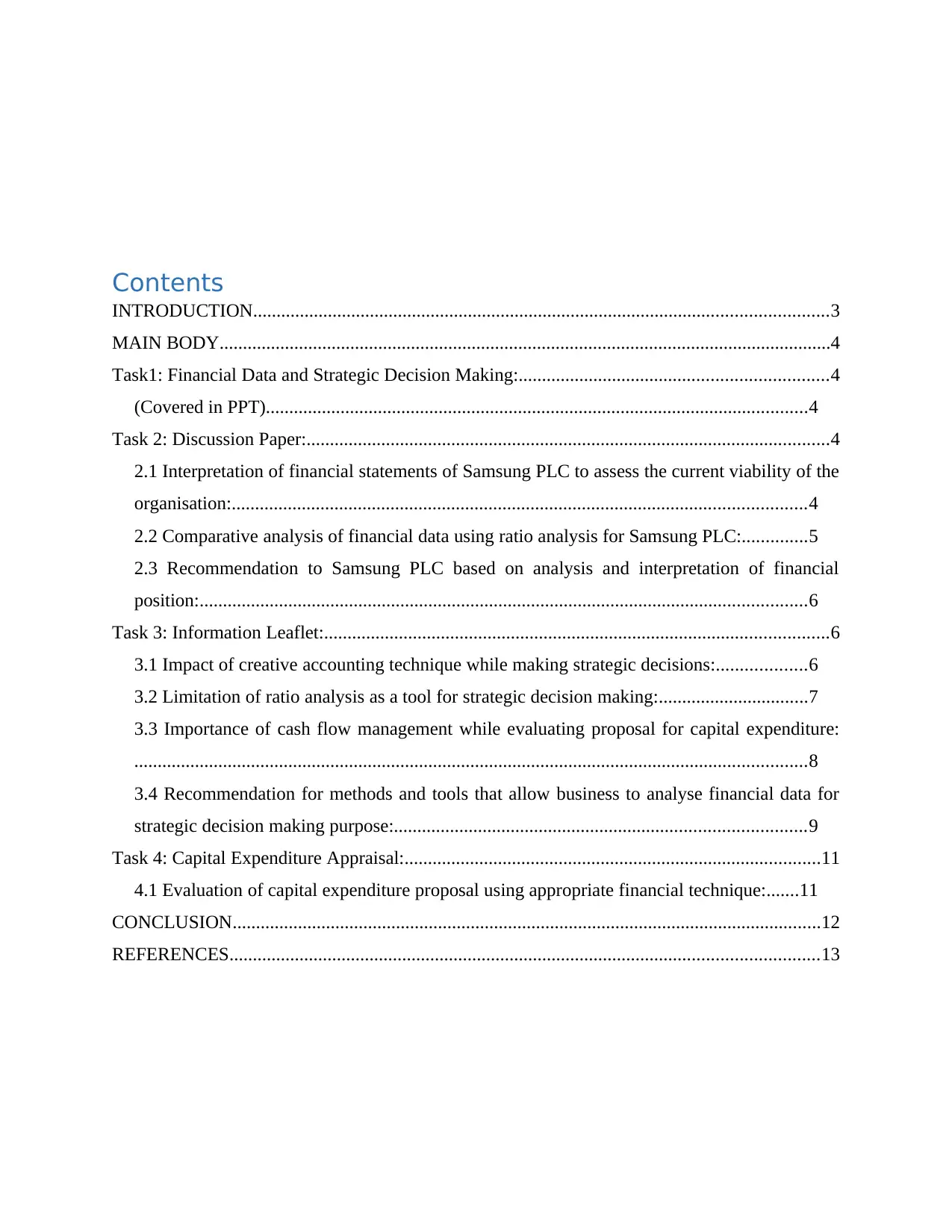
INTRODUCTION...........................................................................................................................3
MAIN BODY...................................................................................................................................4
Task1: Financial Data and Strategic Decision Making:..................................................................4
(Covered in PPT)....................................................................................................................4
Task 2: Discussion Paper:................................................................................................................4
2.1 Interpretation of financial statements of Samsung PLC to assess the current viability of the
organisation:...........................................................................................................................4
2.2 Comparative analysis of financial data using ratio analysis for Samsung PLC:..............5
2.3 Recommendation to Samsung PLC based on analysis and interpretation of financial
position:..................................................................................................................................6
Task 3: Information Leaflet:............................................................................................................6
3.1 Impact of creative accounting technique while making strategic decisions:...................6
3.2 Limitation of ratio analysis as a tool for strategic decision making:................................7
3.3 Importance of cash flow management while evaluating proposal for capital expenditure:
................................................................................................................................................8
3.4 Recommendation for methods and tools that allow business to analyse financial data for
strategic decision making purpose:........................................................................................9
Task 4: Capital Expenditure Appraisal:.........................................................................................11
4.1 Evaluation of capital expenditure proposal using appropriate financial technique:.......11
CONCLUSION..............................................................................................................................12
REFERENCES..............................................................................................................................13
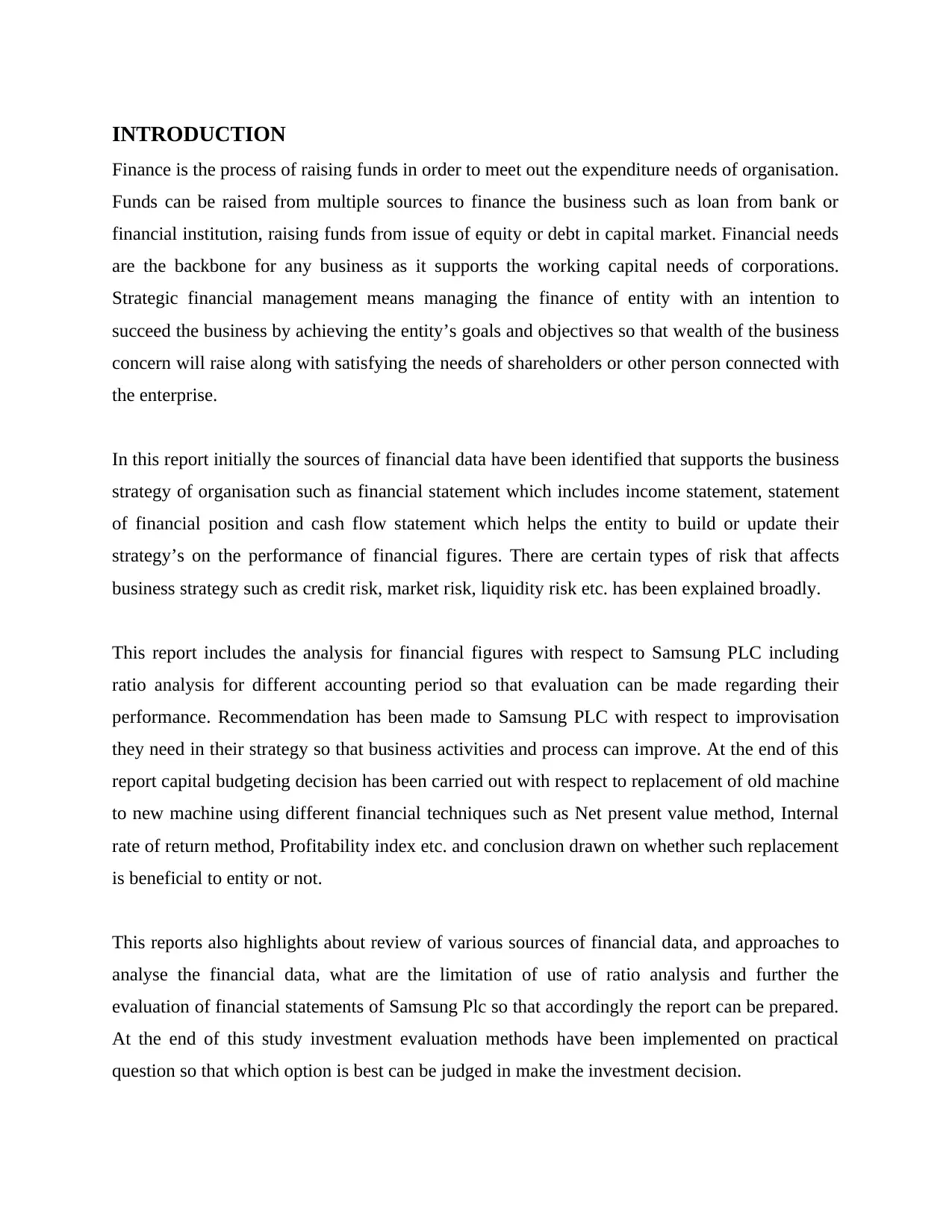
Finance is the process of raising funds in order to meet out the expenditure needs of organisation.
Funds can be raised from multiple sources to finance the business such as loan from bank or
financial institution, raising funds from issue of equity or debt in capital market. Financial needs
are the backbone for any business as it supports the working capital needs of corporations.
Strategic financial management means managing the finance of entity with an intention to
succeed the business by achieving the entity’s goals and objectives so that wealth of the business
concern will raise along with satisfying the needs of shareholders or other person connected with
the enterprise.
In this report initially the sources of financial data have been identified that supports the business
strategy of organisation such as financial statement which includes income statement, statement
of financial position and cash flow statement which helps the entity to build or update their
strategy’s on the performance of financial figures. There are certain types of risk that affects
business strategy such as credit risk, market risk, liquidity risk etc. has been explained broadly.
This report includes the analysis for financial figures with respect to Samsung PLC including
ratio analysis for different accounting period so that evaluation can be made regarding their
performance. Recommendation has been made to Samsung PLC with respect to improvisation
they need in their strategy so that business activities and process can improve. At the end of this
report capital budgeting decision has been carried out with respect to replacement of old machine
to new machine using different financial techniques such as Net present value method, Internal
rate of return method, Profitability index etc. and conclusion drawn on whether such replacement
is beneficial to entity or not.
This reports also highlights about review of various sources of financial data, and approaches to
analyse the financial data, what are the limitation of use of ratio analysis and further the
evaluation of financial statements of Samsung Plc so that accordingly the report can be prepared.
At the end of this study investment evaluation methods have been implemented on practical
question so that which option is best can be judged in make the investment decision.
⊘ This is a preview!⊘
Do you want full access?
Subscribe today to unlock all pages.

Trusted by 1+ million students worldwide
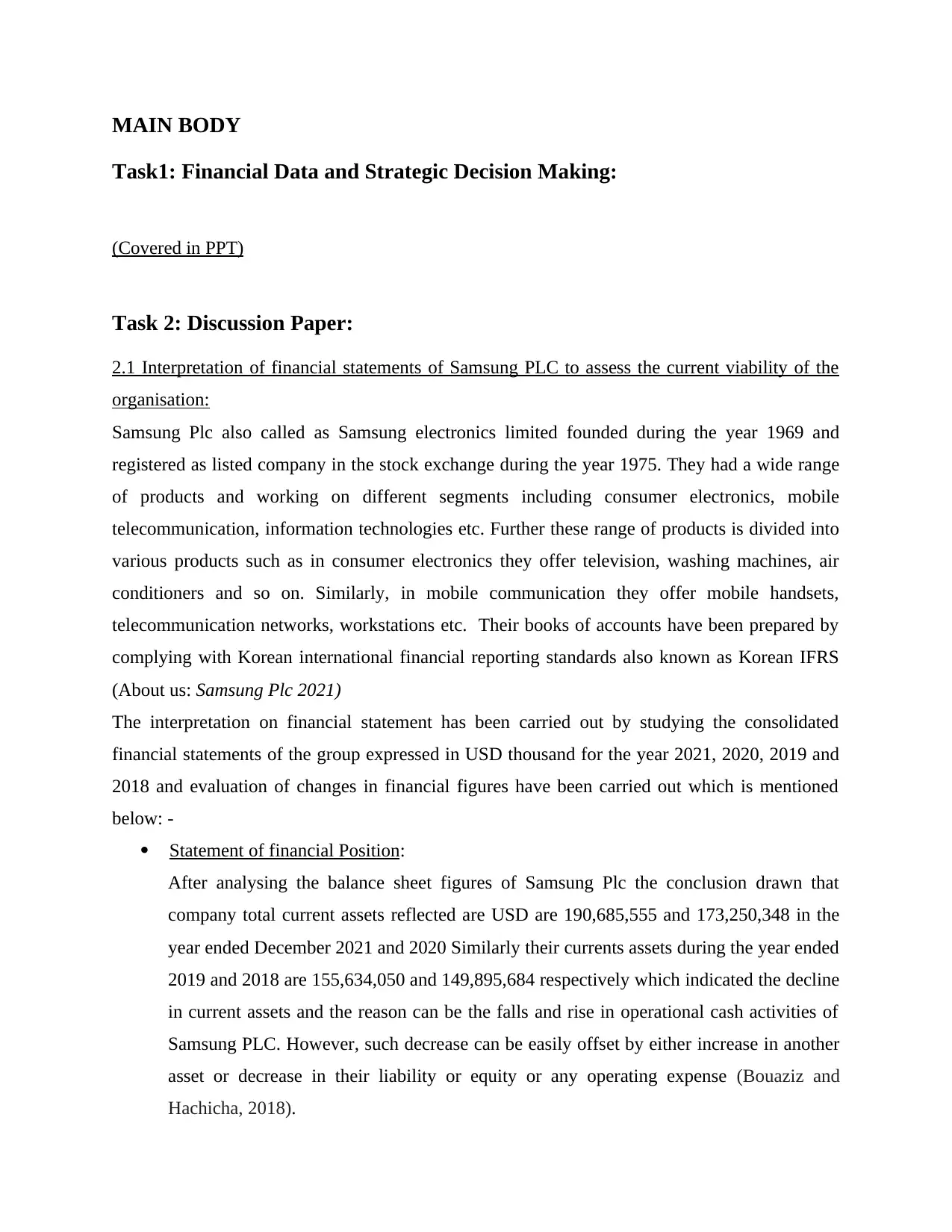
Task1: Financial Data and Strategic Decision Making:
(Covered in PPT)
Task 2: Discussion Paper:
2.1 Interpretation of financial statements of Samsung PLC to assess the current viability of the
organisation:
Samsung Plc also called as Samsung electronics limited founded during the year 1969 and
registered as listed company in the stock exchange during the year 1975. They had a wide range
of products and working on different segments including consumer electronics, mobile
telecommunication, information technologies etc. Further these range of products is divided into
various products such as in consumer electronics they offer television, washing machines, air
conditioners and so on. Similarly, in mobile communication they offer mobile handsets,
telecommunication networks, workstations etc. Their books of accounts have been prepared by
complying with Korean international financial reporting standards also known as Korean IFRS
(About us: Samsung Plc 2021)
The interpretation on financial statement has been carried out by studying the consolidated
financial statements of the group expressed in USD thousand for the year 2021, 2020, 2019 and
2018 and evaluation of changes in financial figures have been carried out which is mentioned
below: -
Statement of financial Position:
After analysing the balance sheet figures of Samsung Plc the conclusion drawn that
company total current assets reflected are USD are 190,685,555 and 173,250,348 in the
year ended December 2021 and 2020 Similarly their currents assets during the year ended
2019 and 2018 are 155,634,050 and 149,895,684 respectively which indicated the decline
in current assets and the reason can be the falls and rise in operational cash activities of
Samsung PLC. However, such decrease can be easily offset by either increase in another
asset or decrease in their liability or equity or any operating expense (Bouaziz and
Hachicha, 2018).
Paraphrase This Document
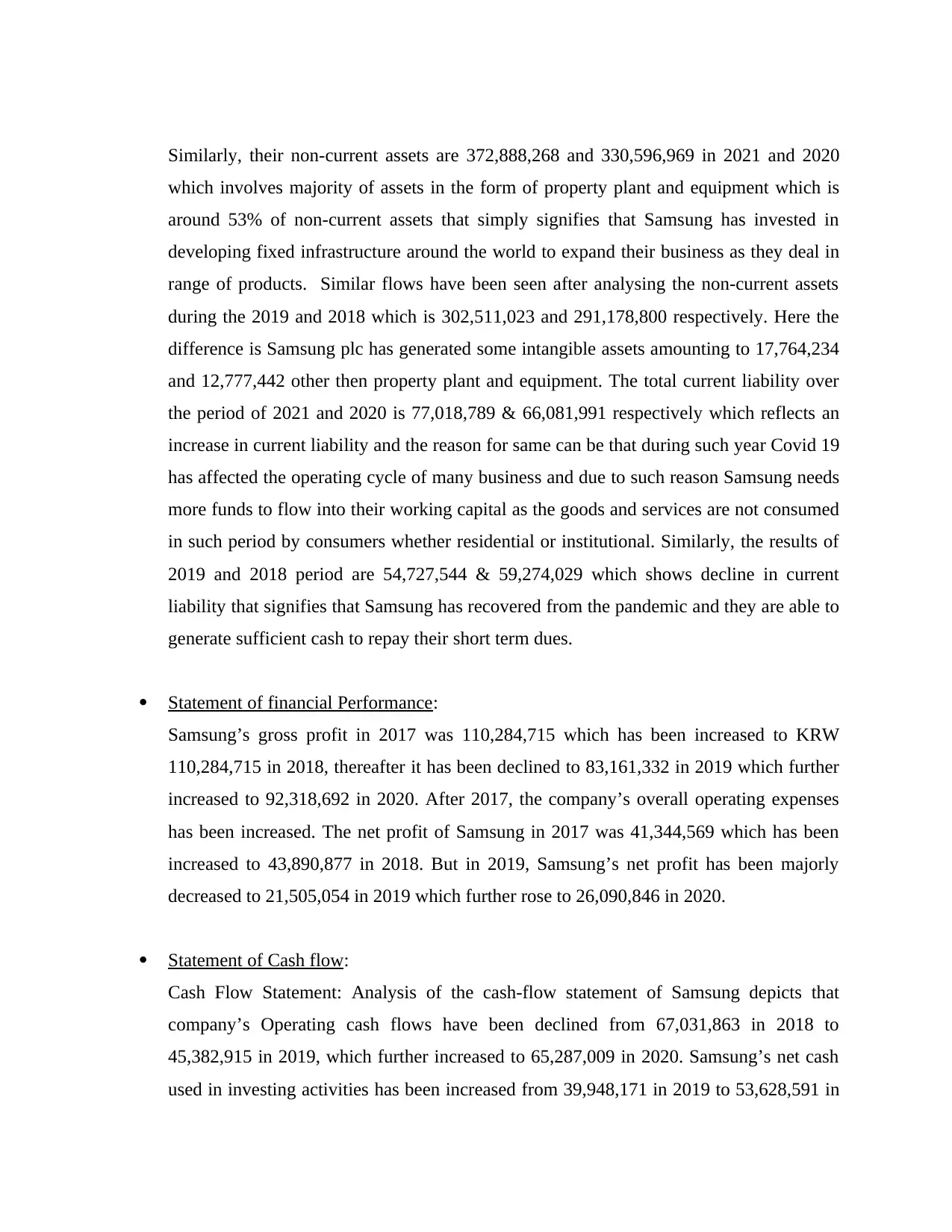
which involves majority of assets in the form of property plant and equipment which is
around 53% of non-current assets that simply signifies that Samsung has invested in
developing fixed infrastructure around the world to expand their business as they deal in
range of products. Similar flows have been seen after analysing the non-current assets
during the 2019 and 2018 which is 302,511,023 and 291,178,800 respectively. Here the
difference is Samsung plc has generated some intangible assets amounting to 17,764,234
and 12,777,442 other then property plant and equipment. The total current liability over
the period of 2021 and 2020 is 77,018,789 & 66,081,991 respectively which reflects an
increase in current liability and the reason for same can be that during such year Covid 19
has affected the operating cycle of many business and due to such reason Samsung needs
more funds to flow into their working capital as the goods and services are not consumed
in such period by consumers whether residential or institutional. Similarly, the results of
2019 and 2018 period are 54,727,544 & 59,274,029 which shows decline in current
liability that signifies that Samsung has recovered from the pandemic and they are able to
generate sufficient cash to repay their short term dues.
Statement of financial Performance:
Samsung’s gross profit in 2017 was 110,284,715 which has been increased to KRW
110,284,715 in 2018, thereafter it has been declined to 83,161,332 in 2019 which further
increased to 92,318,692 in 2020. After 2017, the company’s overall operating expenses
has been increased. The net profit of Samsung in 2017 was 41,344,569 which has been
increased to 43,890,877 in 2018. But in 2019, Samsung’s net profit has been majorly
decreased to 21,505,054 in 2019 which further rose to 26,090,846 in 2020.
Statement of Cash flow:
Cash Flow Statement: Analysis of the cash-flow statement of Samsung depicts that
company’s Operating cash flows have been declined from 67,031,863 in 2018 to
45,382,915 in 2019, which further increased to 65,287,009 in 2020. Samsung’s net cash
used in investing activities has been increased from 39,948,171 in 2019 to 53,628,591 in
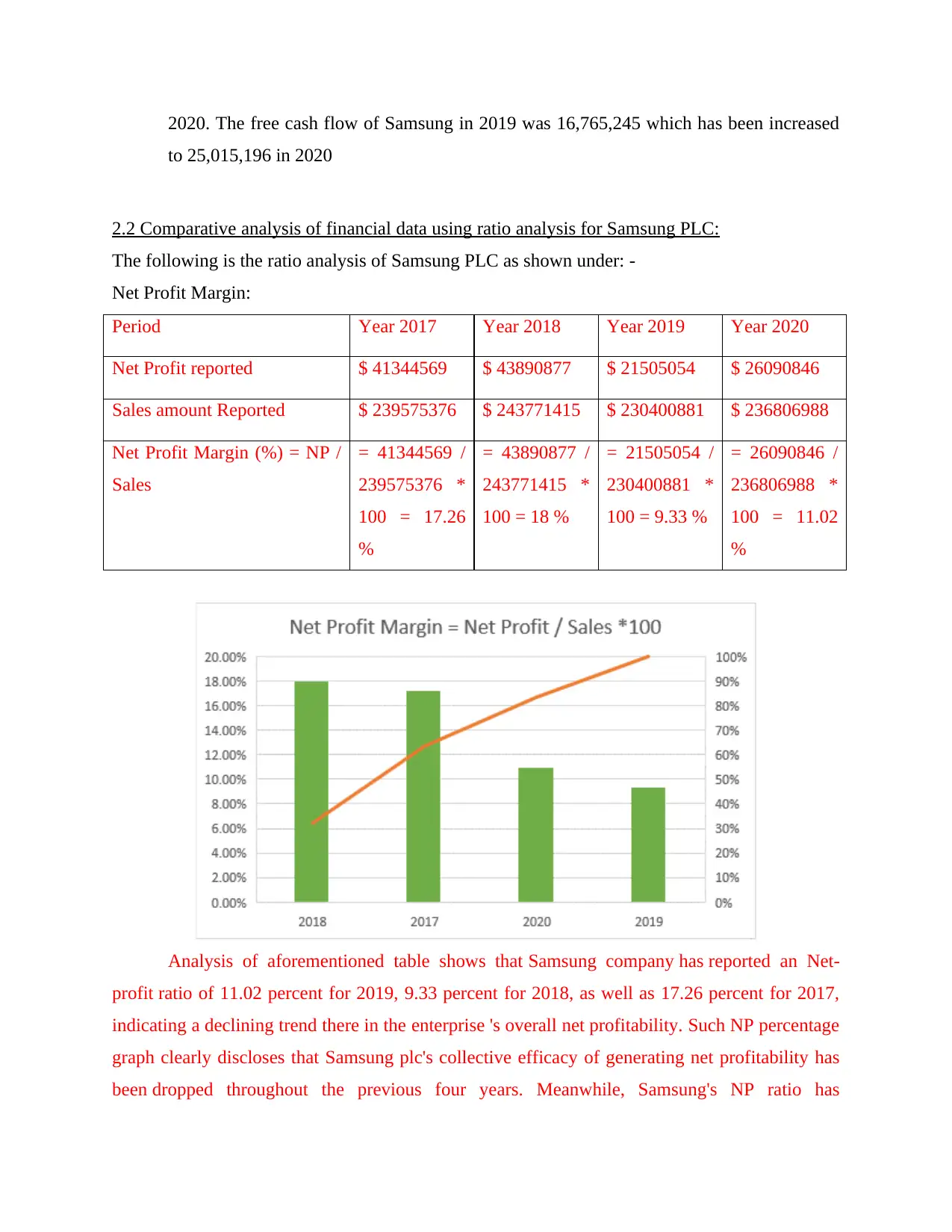
to 25,015,196 in 2020
2.2 Comparative analysis of financial data using ratio analysis for Samsung PLC:
The following is the ratio analysis of Samsung PLC as shown under: -
Net Profit Margin:
Period Year 2017 Year 2018 Year 2019 Year 2020
Net Profit reported $ 41344569 $ 43890877 $ 21505054 $ 26090846
Sales amount Reported $ 239575376 $ 243771415 $ 230400881 $ 236806988
Net Profit Margin (%) = NP /
Sales
= 41344569 /
239575376 *
100 = 17.26
%
= 43890877 /
243771415 *
100 = 18 %
= 21505054 /
230400881 *
100 = 9.33 %
= 26090846 /
236806988 *
100 = 11.02
%
Analysis of aforementioned table shows that Samsung company has reported an Net-
profit ratio of 11.02 percent for 2019, 9.33 percent for 2018, as well as 17.26 percent for 2017,
indicating a declining trend there in the enterprise 's overall net profitability. Such NP percentage
graph clearly discloses that Samsung plc's collective efficacy of generating net profitability has
been dropped throughout the previous four years. Meanwhile, Samsung's NP ratio has
⊘ This is a preview!⊘
Do you want full access?
Subscribe today to unlock all pages.

Trusted by 1+ million students worldwide
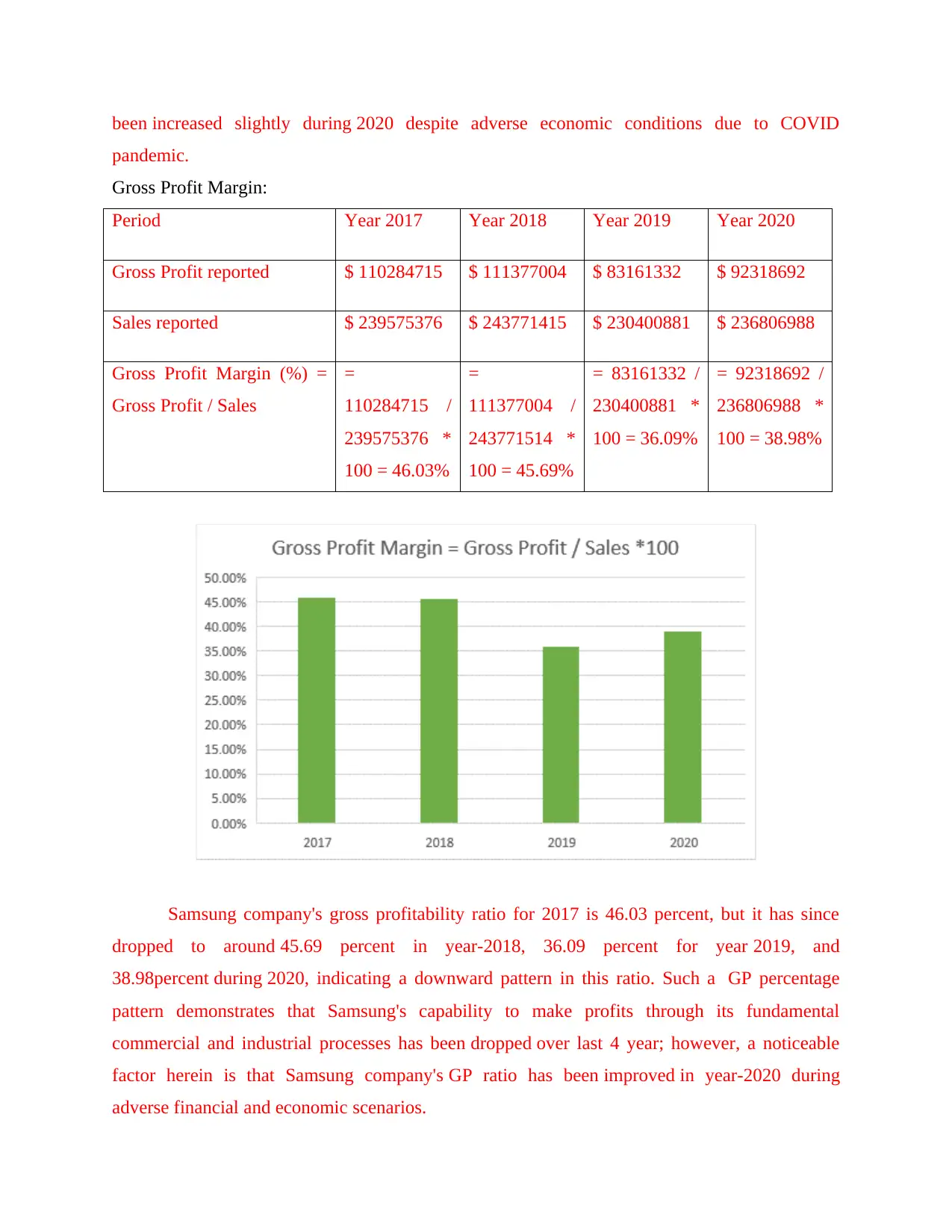
pandemic.
Gross Profit Margin:
Period Year 2017 Year 2018 Year 2019 Year 2020
Gross Profit reported $ 110284715 $ 111377004 $ 83161332 $ 92318692
Sales reported $ 239575376 $ 243771415 $ 230400881 $ 236806988
Gross Profit Margin (%) =
Gross Profit / Sales
=
110284715 /
239575376 *
100 = 46.03%
=
111377004 /
243771514 *
100 = 45.69%
= 83161332 /
230400881 *
100 = 36.09%
= 92318692 /
236806988 *
100 = 38.98%
Samsung company's gross profitability ratio for 2017 is 46.03 percent, but it has since
dropped to around 45.69 percent in year-2018, 36.09 percent for year 2019, and
38.98percent during 2020, indicating a downward pattern in this ratio. Such a GP percentage
pattern demonstrates that Samsung's capability to make profits through its fundamental
commercial and industrial processes has been dropped over last 4 year; however, a noticeable
factor herein is that Samsung company's GP ratio has been improved in year-2020 during
adverse financial and economic scenarios.
Paraphrase This Document
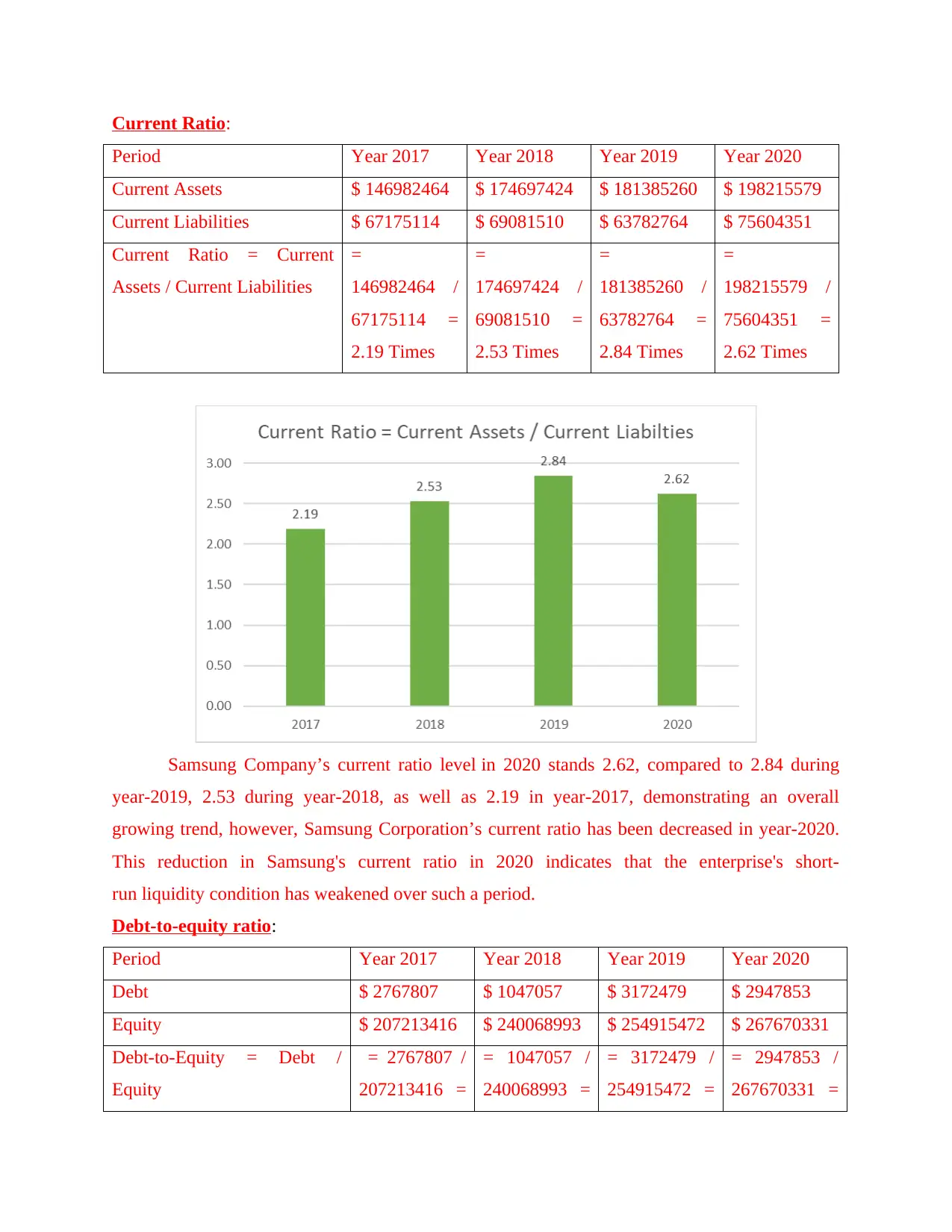
Period Year 2017 Year 2018 Year 2019 Year 2020
Current Assets $ 146982464 $ 174697424 $ 181385260 $ 198215579
Current Liabilities $ 67175114 $ 69081510 $ 63782764 $ 75604351
Current Ratio = Current
Assets / Current Liabilities
=
146982464 /
67175114 =
2.19 Times
=
174697424 /
69081510 =
2.53 Times
=
181385260 /
63782764 =
2.84 Times
=
198215579 /
75604351 =
2.62 Times
Samsung Company’s current ratio level in 2020 stands 2.62, compared to 2.84 during
year-2019, 2.53 during year-2018, as well as 2.19 in year-2017, demonstrating an overall
growing trend, however, Samsung Corporation’s current ratio has been decreased in year-2020.
This reduction in Samsung's current ratio in 2020 indicates that the enterprise's short-
run liquidity condition has weakened over such a period.
Debt-to-equity ratio:
Period Year 2017 Year 2018 Year 2019 Year 2020
Debt $ 2767807 $ 1047057 $ 3172479 $ 2947853
Equity $ 207213416 $ 240068993 $ 254915472 $ 267670331
Debt-to-Equity = Debt /
Equity
= 2767807 /
207213416 =
= 1047057 /
240068993 =
= 3172479 /
254915472 =
= 2947853 /
267670331 =
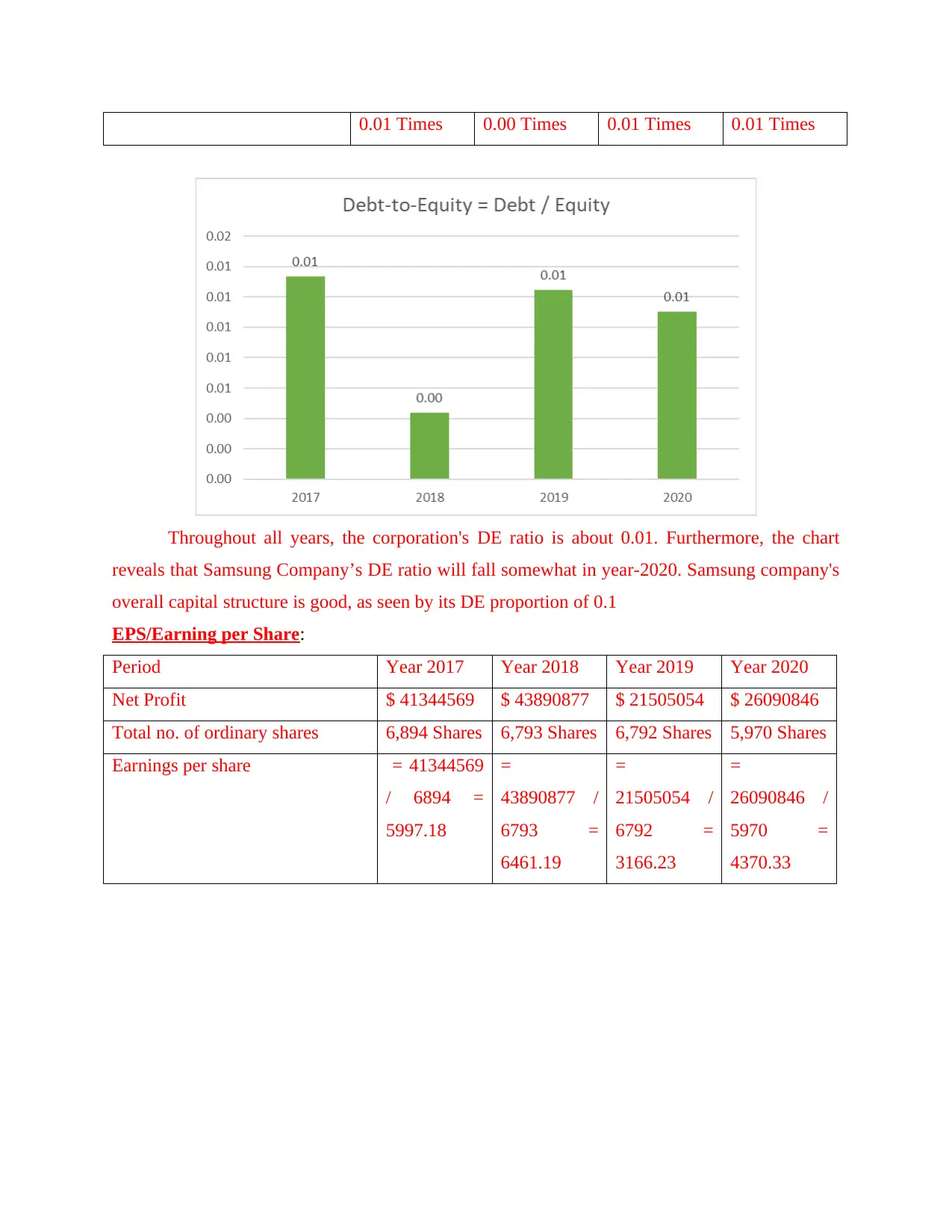
Throughout all years, the corporation's DE ratio is about 0.01. Furthermore, the chart
reveals that Samsung Company’s DE ratio will fall somewhat in year-2020. Samsung company's
overall capital structure is good, as seen by its DE proportion of 0.1
EPS/Earning per Share:
Period Year 2017 Year 2018 Year 2019 Year 2020
Net Profit $ 41344569 $ 43890877 $ 21505054 $ 26090846
Total no. of ordinary shares 6,894 Shares 6,793 Shares 6,792 Shares 5,970 Shares
Earnings per share = 41344569
/ 6894 =
5997.18
=
43890877 /
6793 =
6461.19
=
21505054 /
6792 =
3166.23
=
26090846 /
5970 =
4370.33
⊘ This is a preview!⊘
Do you want full access?
Subscribe today to unlock all pages.

Trusted by 1+ million students worldwide
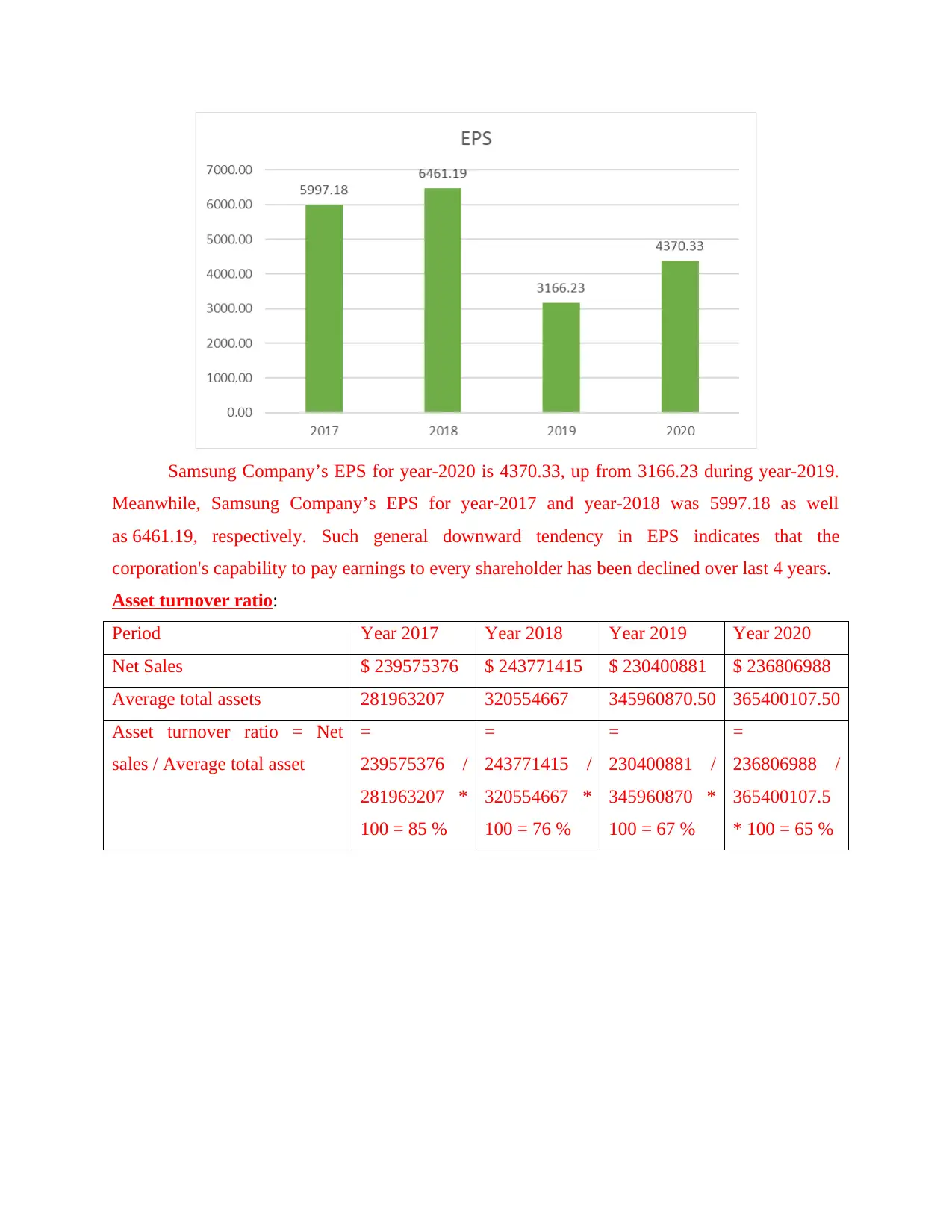
Meanwhile, Samsung Company’s EPS for year-2017 and year-2018 was 5997.18 as well
as 6461.19, respectively. Such general downward tendency in EPS indicates that the
corporation's capability to pay earnings to every shareholder has been declined over last 4 years.
Asset turnover ratio:
Period Year 2017 Year 2018 Year 2019 Year 2020
Net Sales $ 239575376 $ 243771415 $ 230400881 $ 236806988
Average total assets 281963207 320554667 345960870.50 365400107.50
Asset turnover ratio = Net
sales / Average total asset
=
239575376 /
281963207 *
100 = 85 %
=
243771415 /
320554667 *
100 = 76 %
=
230400881 /
345960870 *
100 = 67 %
=
236806988 /
365400107.5
* 100 = 65 %
Paraphrase This Document

has steadily declined over the previous four years. Such a falling pattern in Samsung's Assets
turnover ratio demonstrates that Samsung's competence in utilising their overall assets has
been worsened. The entire ratio assessment of Samsung company reveals that the enterprise's
performance level during year-2019 has been fallen owing to weaker demand, intense
competitiveness, US-China trade conflict including impacts of Brexit. However, amid the
COVID-19 epidemic, Samsung's total performance during 2020 has been strengthened,
indicating that the corporation's productivity in the future year would enhance.
2.3 Recommendation to Samsung PLC based on analysis and interpretation of financial position:
According to Samsung Plc's performance review and study, the corporation should persist with
its present marketing approach and target developing markets like India, Shri Lanka, China, as
well as other Parts of Asia. Moreover, it's been advised that the corporation should raise their
overall research and development expenditure in an attempt to offer clients more innovative or
remarkable products. For strengthening its total profitability level, Samsung should consider
reducing overall operating expenses. Samsung should also reallocate inefficient operations and
consider outsourcing tasks that are producing excessive expenditures for the organization in
order to cut operational expenditures. Furthermore, in order to attain an optimal capital structure
with a lower debt level, the enterprise should reduce its longer-term and shorter-term
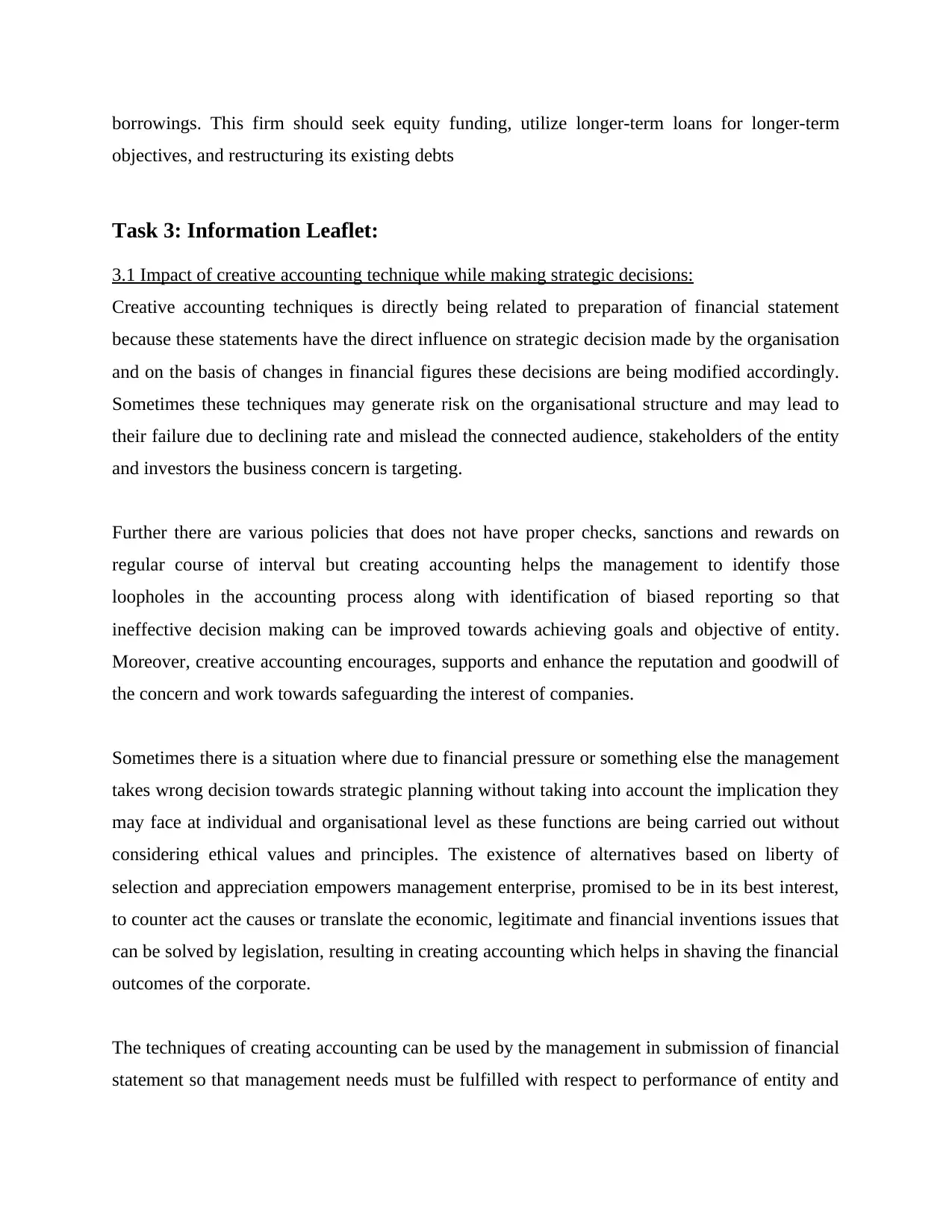
objectives, and restructuring its existing debts
Task 3: Information Leaflet:
3.1 Impact of creative accounting technique while making strategic decisions:
Creative accounting techniques is directly being related to preparation of financial statement
because these statements have the direct influence on strategic decision made by the organisation
and on the basis of changes in financial figures these decisions are being modified accordingly.
Sometimes these techniques may generate risk on the organisational structure and may lead to
their failure due to declining rate and mislead the connected audience, stakeholders of the entity
and investors the business concern is targeting.
Further there are various policies that does not have proper checks, sanctions and rewards on
regular course of interval but creating accounting helps the management to identify those
loopholes in the accounting process along with identification of biased reporting so that
ineffective decision making can be improved towards achieving goals and objective of entity.
Moreover, creative accounting encourages, supports and enhance the reputation and goodwill of
the concern and work towards safeguarding the interest of companies.
Sometimes there is a situation where due to financial pressure or something else the management
takes wrong decision towards strategic planning without taking into account the implication they
may face at individual and organisational level as these functions are being carried out without
considering ethical values and principles. The existence of alternatives based on liberty of
selection and appreciation empowers management enterprise, promised to be in its best interest,
to counter act the causes or translate the economic, legitimate and financial inventions issues that
can be solved by legislation, resulting in creating accounting which helps in shaving the financial
outcomes of the corporate.
The techniques of creating accounting can be used by the management in submission of financial
statement so that management needs must be fulfilled with respect to performance of entity and
⊘ This is a preview!⊘
Do you want full access?
Subscribe today to unlock all pages.

Trusted by 1+ million students worldwide

corruption in the society and there is failure of entity is every part of the world leads to demand
of accounting professionals so that code of ethics will be complied accordingly. Increaser in the
percentage of corruption also requires the scrutiny of work carried out by the public accountant
by the professional body on individual basis so that mistakes can be resolved by the organisation.
3.2 Limitation of ratio analysis as a tool for strategic decision making:
Ratio analysis has been carried out only when financial figures has been given for the given set
of data. If financial statements are inflated, then the results so obtained on carrying out ratio
analysis does not provide correct results. It is duty of management to ensure that motivational
and reward programs must be carried out in between regular intervals so that the management of
the entity specially accounting department does not engage in any type of manipulation with
respect of financial figures.
Extensive expertise and financial data is needed to describe the implication of various ratios
which is trending in business concern situation. With the help of ratio analysis, the performance
of the entity can be judged by comparing the financial figures of the corporate. This analysis is
helpful to develop the strategic decision accordingly as it completely highlight the positioning of
the firm historically and what would be in future based on predication in the market and against
its competitors.
The wrong decisions will lead to affecting the decision making of entity at the top and middle
level which are responsible for making the policy so that operations can be carried out smoothly.
The another limitation of ratio analysis is that it only shows what is too be needed and only
connected with monetary performance and does not consider the non-monetary factors in the
organisations such as high labour turnover rate, wages and salary hikes are not been carried out
regularly, dispute of management with labour union etc., these factors also affects the
effectiveness and efficiency of entity during the accounting period. The performance of the ratio
also depends upon the method on which books of accounts has been prepared by entity such as
on historical cost basis or fair value model.
Paraphrase This Document

and their changes taken place and then their usefulness will have ended up being nothing but
window dressing. Further they also do not consider the changes taken place in price of the
products and services the entity offers due to change in rate of inflation. Not only this many
ratios are being calculated suing historical cost and they do not consider changes that have been
taken place in between the periods and the results is true picture does not come in front.
The strategic decision depends upon the results that provide by such ratio but the difference is
that such ratio results depends upon the formulae used which is different from firm to firms. One
of the example can be that current ratio is calculated by dividing current assets upon current
liability’s however certain firms will ignore bank overdraft as part of current liability and some
do and the ultimate ratio that arrives differs completely and therefore directly affect the
interpretation and strategic decision which is based on those results.
Further they do not solve the problems faced by the corporate financially during the accreting
period therefore we can say that such ratio does not provide actual solution to the corporate for
the problems they are facing. Therefore, we can say that the strategic planning we must not be
completely depend on such tool and must consider other non-monetary factors too while
implementing policy with respect to entity.
3.3 Importance of cash flow management while evaluating proposal for capital expenditure:
The capital expenditure has been taken place when the entity needs to invest in equipment or
facility as they are non-recurring expenditure which affects the liquidity of entity as the amount
of cash involved in higher for such investment. Due to this reason only the management of cash
flow plays a vital role in entity because it directly supports the capital expenditure planning of
enterprise. The cash flow management reflects the liquidity of the entity and if liquidity is not
stronger for the entity then they do not able to contribute to large investment.
The primary goal of cash flow management is to comprehend and minimise the processing cost
so that capital investments projects can be evaluated from both inside the organisation and
outside with other enterprise. In the cash flow are not properly managed then it will result in
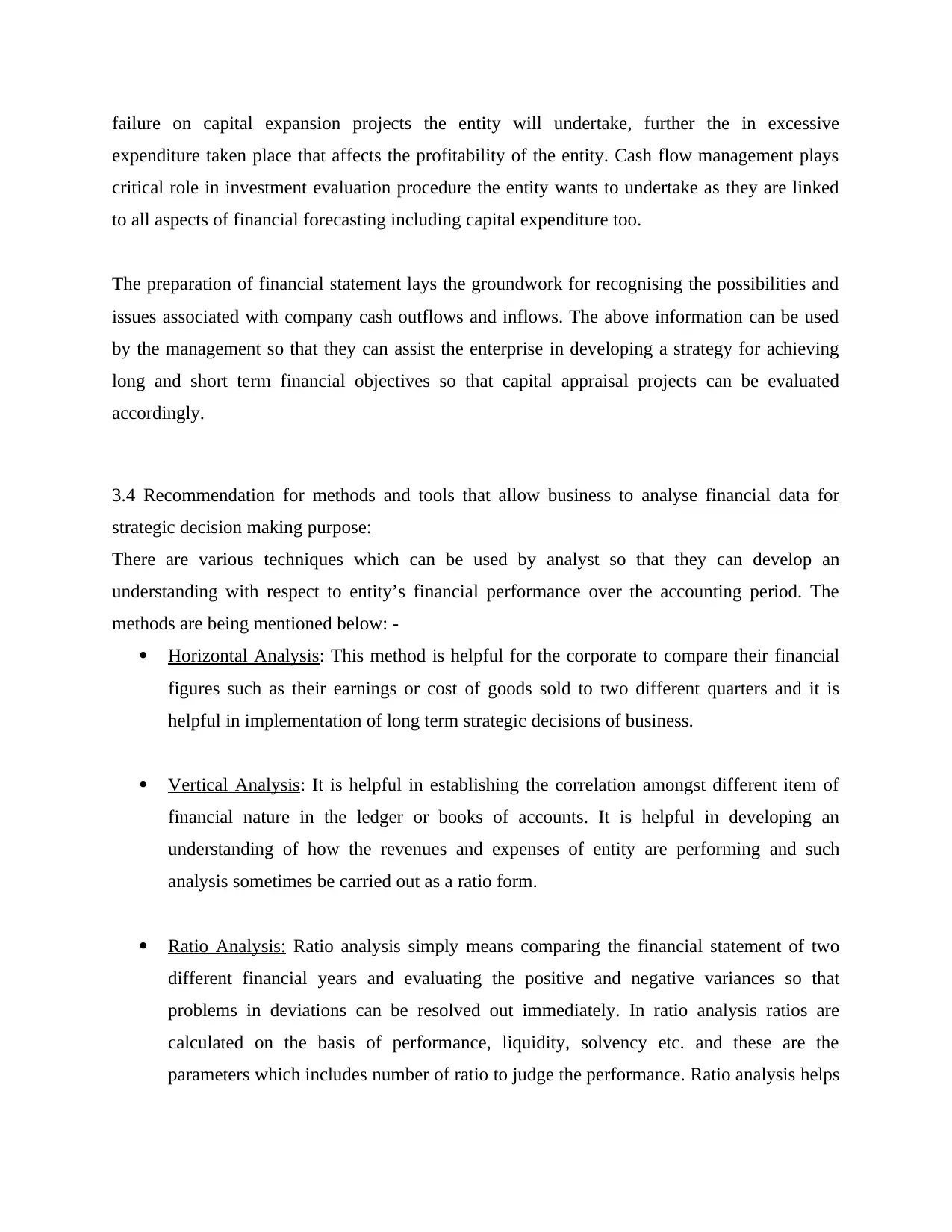
expenditure taken place that affects the profitability of the entity. Cash flow management plays
critical role in investment evaluation procedure the entity wants to undertake as they are linked
to all aspects of financial forecasting including capital expenditure too.
The preparation of financial statement lays the groundwork for recognising the possibilities and
issues associated with company cash outflows and inflows. The above information can be used
by the management so that they can assist the enterprise in developing a strategy for achieving
long and short term financial objectives so that capital appraisal projects can be evaluated
accordingly.
3.4 Recommendation for methods and tools that allow business to analyse financial data for
strategic decision making purpose:
There are various techniques which can be used by analyst so that they can develop an
understanding with respect to entity’s financial performance over the accounting period. The
methods are being mentioned below: -
Horizontal Analysis: This method is helpful for the corporate to compare their financial
figures such as their earnings or cost of goods sold to two different quarters and it is
helpful in implementation of long term strategic decisions of business.
Vertical Analysis: It is helpful in establishing the correlation amongst different item of
financial nature in the ledger or books of accounts. It is helpful in developing an
understanding of how the revenues and expenses of entity are performing and such
analysis sometimes be carried out as a ratio form.
Ratio Analysis: Ratio analysis simply means comparing the financial statement of two
different financial years and evaluating the positive and negative variances so that
problems in deviations can be resolved out immediately. In ratio analysis ratios are
calculated on the basis of performance, liquidity, solvency etc. and these are the
parameters which includes number of ratio to judge the performance. Ratio analysis helps
⊘ This is a preview!⊘
Do you want full access?
Subscribe today to unlock all pages.

Trusted by 1+ million students worldwide
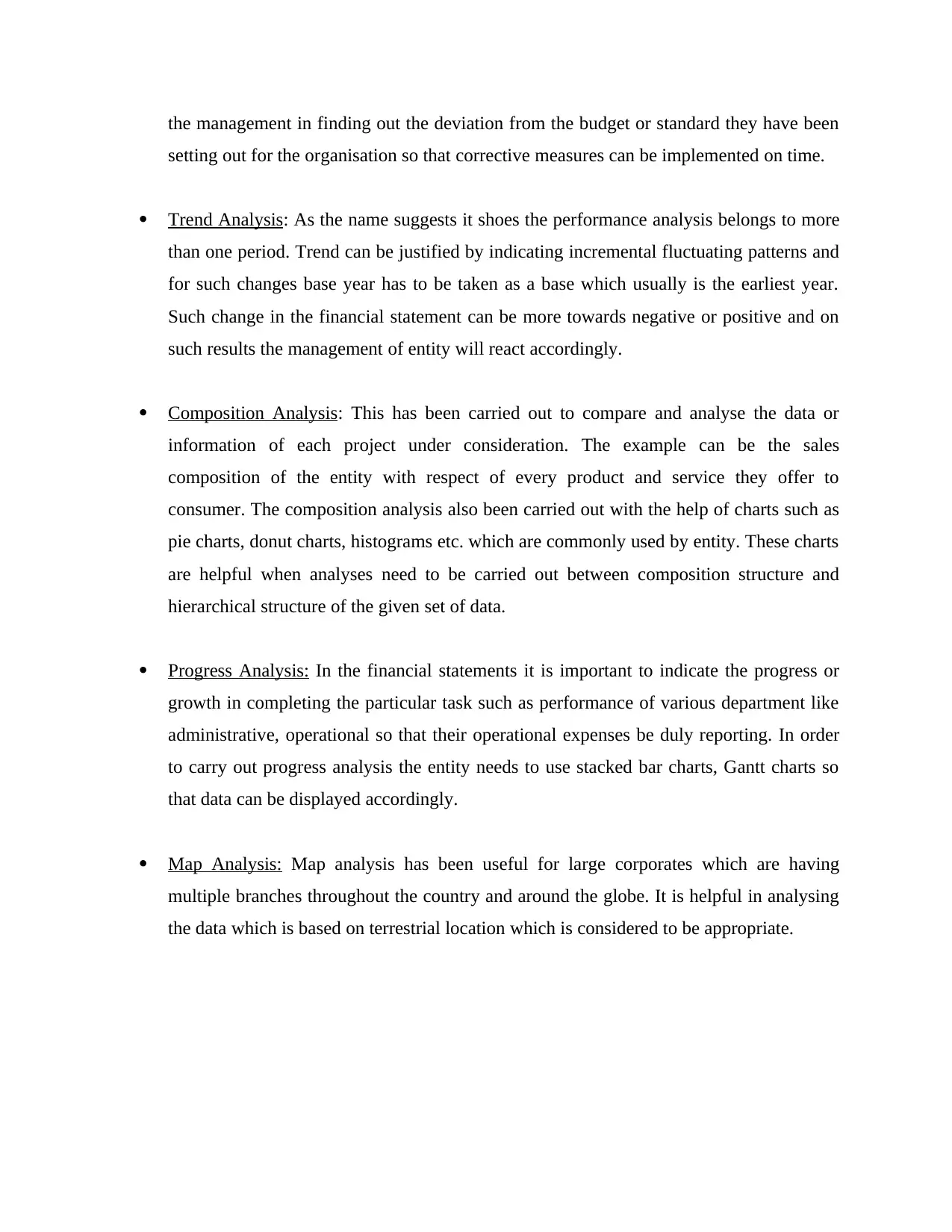
setting out for the organisation so that corrective measures can be implemented on time.
Trend Analysis: As the name suggests it shoes the performance analysis belongs to more
than one period. Trend can be justified by indicating incremental fluctuating patterns and
for such changes base year has to be taken as a base which usually is the earliest year.
Such change in the financial statement can be more towards negative or positive and on
such results the management of entity will react accordingly.
Composition Analysis: This has been carried out to compare and analyse the data or
information of each project under consideration. The example can be the sales
composition of the entity with respect of every product and service they offer to
consumer. The composition analysis also been carried out with the help of charts such as
pie charts, donut charts, histograms etc. which are commonly used by entity. These charts
are helpful when analyses need to be carried out between composition structure and
hierarchical structure of the given set of data.
Progress Analysis: In the financial statements it is important to indicate the progress or
growth in completing the particular task such as performance of various department like
administrative, operational so that their operational expenses be duly reporting. In order
to carry out progress analysis the entity needs to use stacked bar charts, Gantt charts so
that data can be displayed accordingly.
Map Analysis: Map analysis has been useful for large corporates which are having
multiple branches throughout the country and around the globe. It is helpful in analysing
the data which is based on terrestrial location which is considered to be appropriate.
Paraphrase This Document
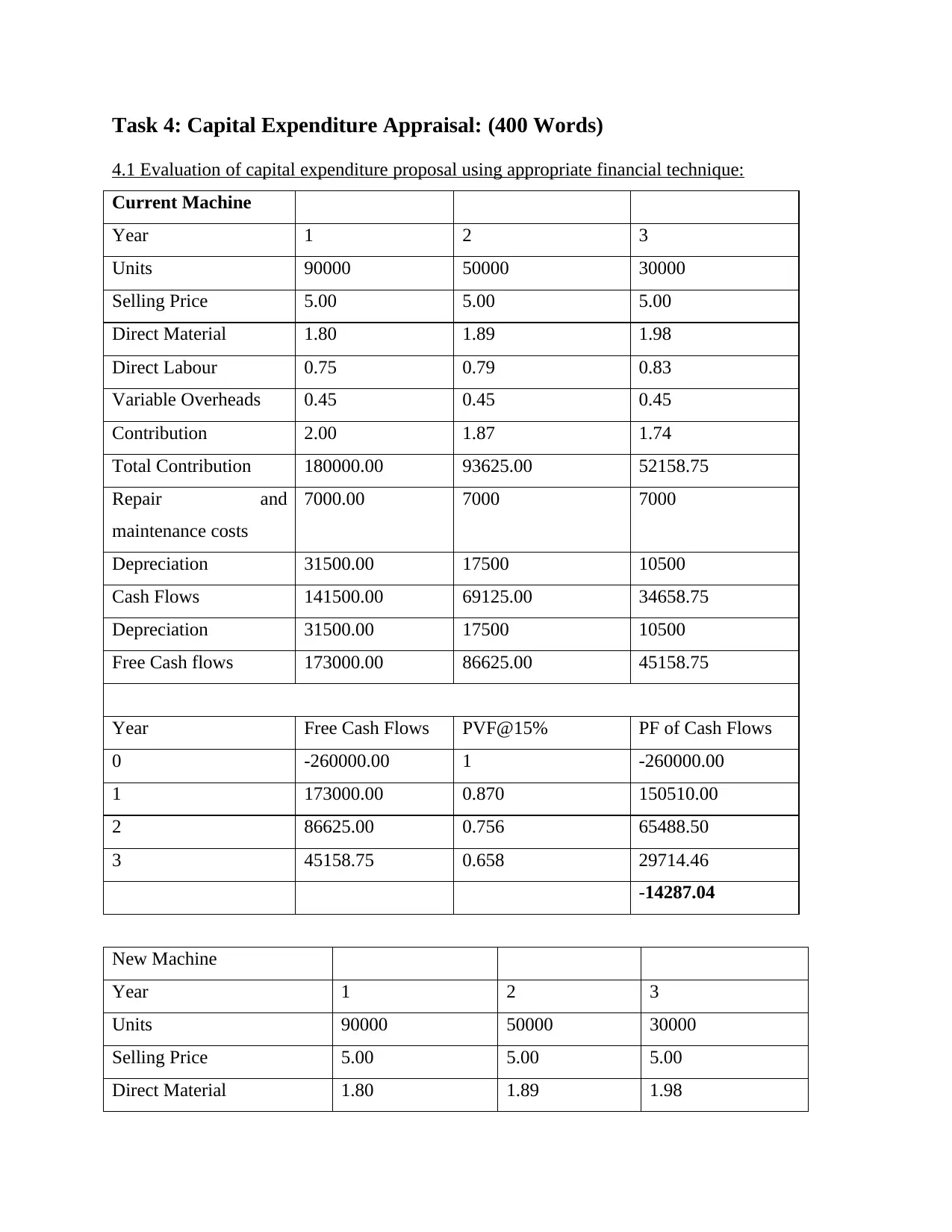
4.1 Evaluation of capital expenditure proposal using appropriate financial technique:
Current Machine
Year 1 2 3
Units 90000 50000 30000
Selling Price 5.00 5.00 5.00
Direct Material 1.80 1.89 1.98
Direct Labour 0.75 0.79 0.83
Variable Overheads 0.45 0.45 0.45
Contribution 2.00 1.87 1.74
Total Contribution 180000.00 93625.00 52158.75
Repair and
maintenance costs
7000.00 7000 7000
Depreciation 31500.00 17500 10500
Cash Flows 141500.00 69125.00 34658.75
Depreciation 31500.00 17500 10500
Free Cash flows 173000.00 86625.00 45158.75
Year Free Cash Flows PVF@15% PF of Cash Flows
0 -260000.00 1 -260000.00
1 173000.00 0.870 150510.00
2 86625.00 0.756 65488.50
3 45158.75 0.658 29714.46
-14287.04
New Machine
Year 1 2 3
Units 90000 50000 30000
Selling Price 5.00 5.00 5.00
Direct Material 1.80 1.89 1.98
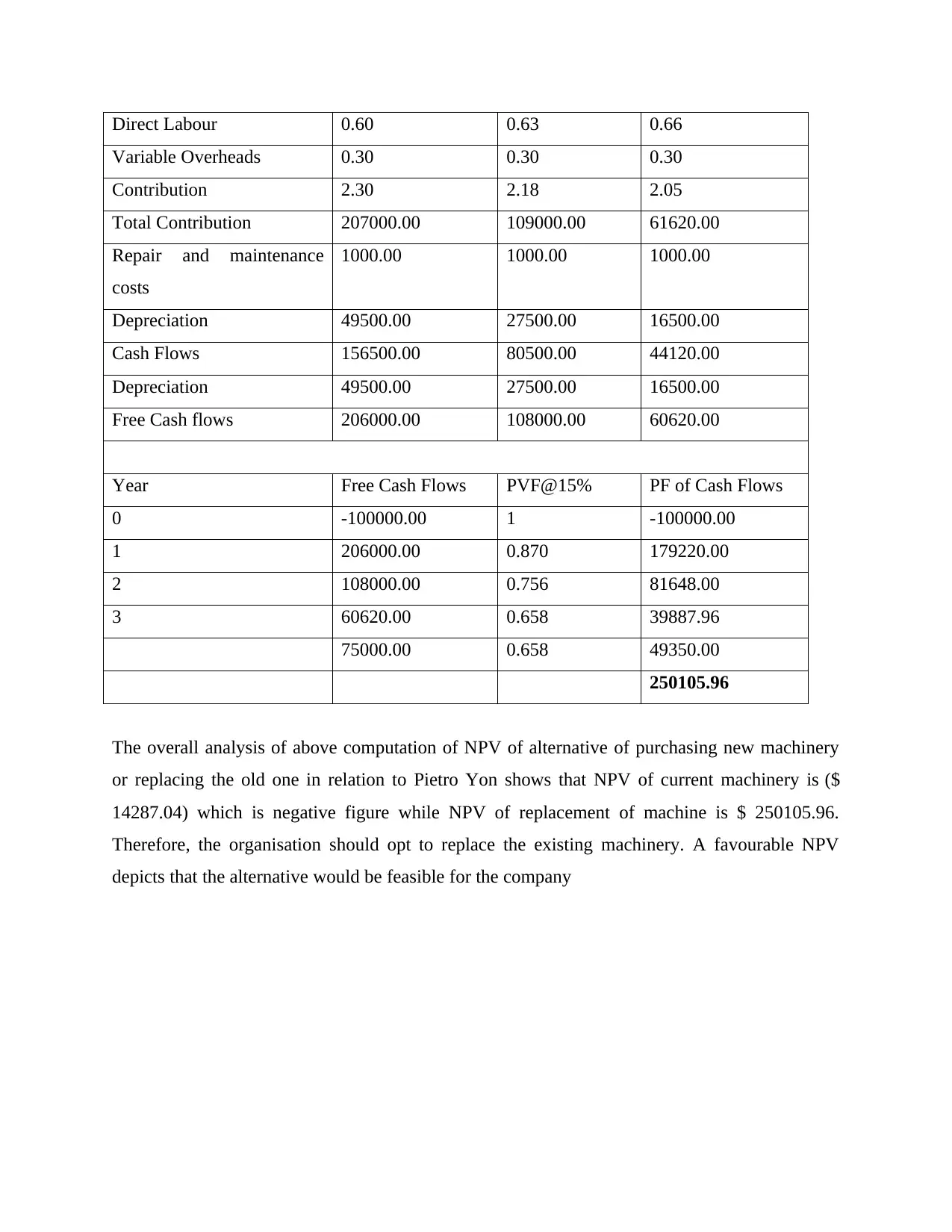
Variable Overheads 0.30 0.30 0.30
Contribution 2.30 2.18 2.05
Total Contribution 207000.00 109000.00 61620.00
Repair and maintenance
costs
1000.00 1000.00 1000.00
Depreciation 49500.00 27500.00 16500.00
Cash Flows 156500.00 80500.00 44120.00
Depreciation 49500.00 27500.00 16500.00
Free Cash flows 206000.00 108000.00 60620.00
Year Free Cash Flows PVF@15% PF of Cash Flows
0 -100000.00 1 -100000.00
1 206000.00 0.870 179220.00
2 108000.00 0.756 81648.00
3 60620.00 0.658 39887.96
75000.00 0.658 49350.00
250105.96
The overall analysis of above computation of NPV of alternative of purchasing new machinery
or replacing the old one in relation to Pietro Yon shows that NPV of current machinery is ($
14287.04) which is negative figure while NPV of replacement of machine is $ 250105.96.
Therefore, the organisation should opt to replace the existing machinery. A favourable NPV
depicts that the alternative would be feasible for the company
⊘ This is a preview!⊘
Do you want full access?
Subscribe today to unlock all pages.

Trusted by 1+ million students worldwide

From the above discussion and analysis in the report, this has been ascertained that a Strategic
decision-making procedure is a continuous procedure that entails developing strategies to
accomplish targets and revising plans depending on results. Strategic decision-making has a far
larger perspective which is not constrained by present operational business procedures, and it
involves visualising completely new company directions, as well as completely new corporate
procedures and competencies that may be needed for such paths.
The above report highlights regarding financial data sources that could be utilized by the
business concern to develop the business strategy and also evaluated the financial data as well
the information with respect to business strategy followed by the corporate. In this report the
financial performance of Samsung PLC has been evaluated for the year 2021,2020,2019 and
2018 and interpretation has been made on their performance along with certain recommendation
that how they enhance their profitability in future so that competitive advantage can be
maintained against the competitors.
Further to judge their performance ratio analysis has been carried out which includes
interpretation based on profitability ratio such as net profit ratio, gross profit ratio etc., solvency
ratio such as debt equity ratio, interest coverage ratio, proprietary ratio, efficiency ratio such as
inventory turnover, accounts receivable ratio, accounts payable ratio, fixed asset turnover ratio,
working capital ratio etc. and along with the calculation of above ratio their graphical
representation has been conducted.
Further this paper also explains about what is creating accounting and its significance on
strategic business decision of the enterprise and limitation of ratio analysis on the organisation as
a whole in relation to strategic decision making. Cash flow management and its importance to
business when they are undertaking any capital expenditure projects is highlighted in a
sequential manner and approach.
At the end of this report capital budgeting decision has been carried out relating to replacement
old machine with old machine using different appraisal techniques so that management can
Paraphrase This Document

machine. Further there are various appraisal techniques such as net present value, profitability
index, discounted payback period, payback period, average rate of return method etc.
The above methods are used by the corporate to evaluate the feasibility of the project which is
under consideration so that entity could take decision with respect to whether such project is
beneficial for the enterprise or not. From the above the best and most practical method is Net
present value method as it considers time value of money and the results obtained from such
method is suitable for decision making.
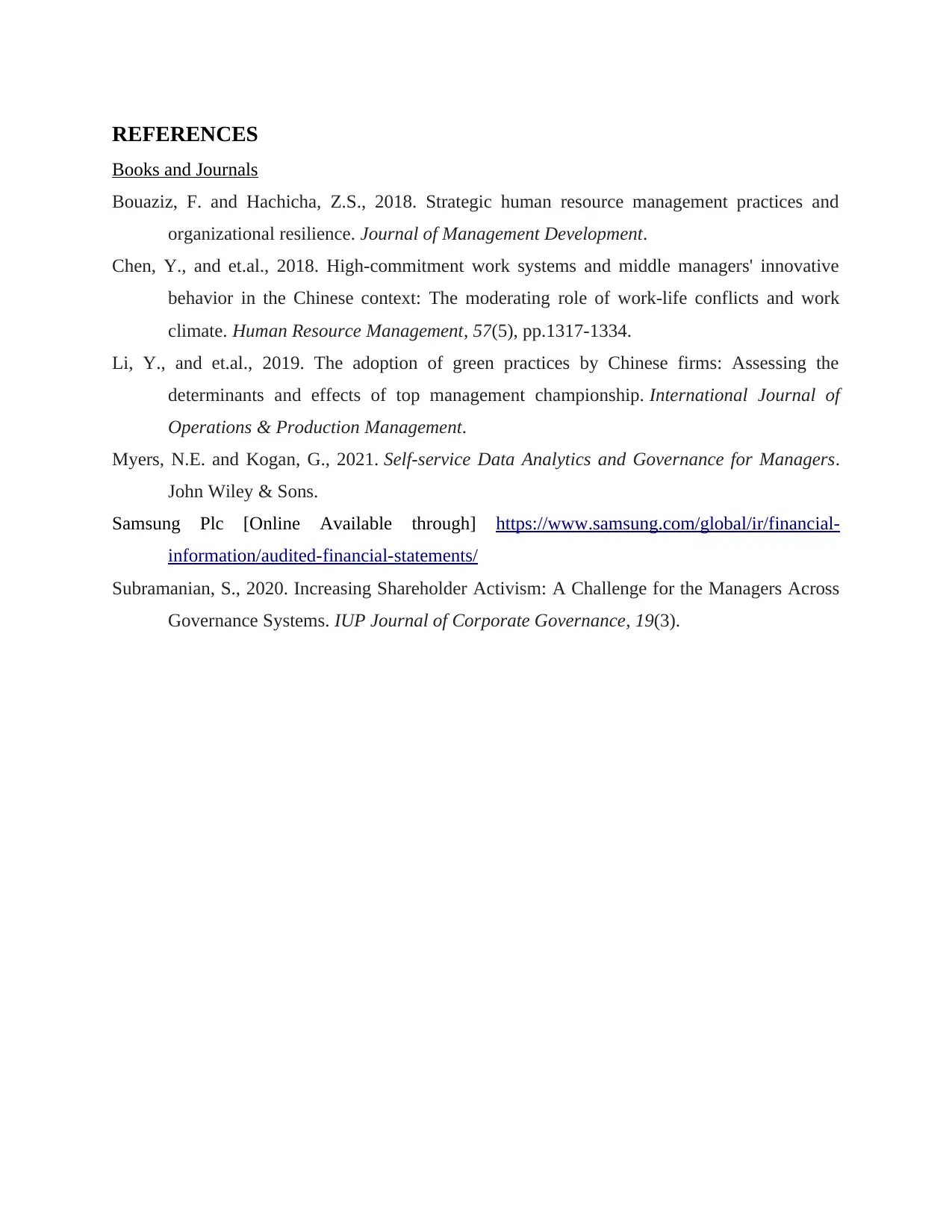
Books and Journals
Bouaziz, F. and Hachicha, Z.S., 2018. Strategic human resource management practices and
organizational resilience. Journal of Management Development.
Chen, Y., and et.al., 2018. High‐commitment work systems and middle managers' innovative
behavior in the Chinese context: The moderating role of work‐life conflicts and work
climate. Human Resource Management, 57(5), pp.1317-1334.
Li, Y., and et.al., 2019. The adoption of green practices by Chinese firms: Assessing the
determinants and effects of top management championship. International Journal of
Operations & Production Management.
Myers, N.E. and Kogan, G., 2021. Self-service Data Analytics and Governance for Managers.
John Wiley & Sons.
Samsung Plc [Online Available through] https://www.samsung.com/global/ir/financial-
information/audited-financial-statements/
Subramanian, S., 2020. Increasing Shareholder Activism: A Challenge for the Managers Across
Governance Systems. IUP Journal of Corporate Governance, 19(3).
⊘ This is a preview!⊘
Do you want full access?
Subscribe today to unlock all pages.

Trusted by 1+ million students worldwide
Related Documents
Your All-in-One AI-Powered Toolkit for Academic Success.
+13062052269
info@desklib.com
Available 24*7 on WhatsApp / Email
![[object Object]](/_next/static/media/star-bottom.7253800d.svg)
© 2024 | Zucol Services PVT LTD | All rights reserved.





